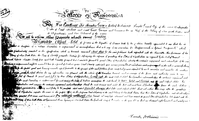


Chapter 9
I Introduction
II The Australian Chemical Industry
i Beginnings 1865-1919
ii Fertilisers
iii Raw materials from gasworks and coke ovens
iv The beginnings of industrial chemical research - in the sugar industry
v Explosives
III Pharmaceuticals
IV Chemists In Other Industries
V The Dawn Of Modern Chemical Industry - High Pressure Synthesis
VI The Growth Of Synthetic Chemicals - Concentration, Rationalisation And International Links
VII Australian Industrial Chemical Research Laboratories
VIII The Plastics Industry
IX The Paint Industry
X Acknowledgements
References
Index
Search
Help
Contact us

Explosives
One of the earliest records on Australian chemical technology is the 'Index to NSW, Letters of Registrations of Inventions' which 'embraces references to all patents enrolled for the thirty-three years following the introduction of Patent Law into this country'.[22] It reflects the preoccupation of the minds of the inventors and pioneers of the time: 150 patents on agriculture, mainly on basic needs -30 patents on fencing, to separate cattle; -10 on stump extractors, to change bushland into fields; -12 on artificial fertilisers and a few simple recipes to exterminate vermin. By contrast, mining was already sophisticated: -240 patents on minerals, their separation and alloys; 38 on mining processes, including some of the world's great inventions of the day -the Nobel patents.
Explosives for gold-miners
Explosives occupy a key position in Australia's development:
- They were the basic enabling tool for mining, from gold to coal;
- they were the basis of chemical companies and of the early concentration of the industry in Australia
- development in Australia contributed significantly to the three revolutions in explosives: From blasting powder to fuse ignition of nitroglycerine and dynamite; from dynamite to gelignite; and, particularly, through research in the 1960s and 1970s, from gelignite to ammonium nitrate/fuel oil slurries and emulsions.
Australian goldminers were quick to appreciate that explosives would reduce the drudgery of breaking hard Australian ground with pick and shovel. More importantly, their productivity multiplied with the use of explosives. The nineteenth century was the age of major public works depending on rock breaking and moving earth; railway tracks, the Suez Canal, tunnels through the Alps, all demanded explosives and until the 1860s relied exclusively on mediaeval gunpowder, a mixture of potassium nitrate, carbon and sulphur variously modified with chlorates, other nitrates and solid additives. As elsewhere, Australian engineers and miners relied on black powder for rock breaking. There are reports on its importation (Learmonth, 1934, see Mercer,[23] 1985), storage and safety legislation (1828) and on its use for a large water tunnel in Sydney, Busby's Bore, completed in 1837. A fuse factory was established in 1867, a black powder factory in Victoria in 1873 and by 1876 there were at least five producers. Indeed the NSW Patent Register (Potter, 1890) would indicate that manufacture began, or was at least intended, before then, since Thomas Martin filed Australian patent 103 on January 5, 1865. Martin's recipe was a typical black blasting powder modification, using solids which were locally available, e.g. tan, bark, peat and/or sawdust. Black powder, however, was not the most powerful explosive known at the time. In 1842, the Italian Ascanio Sobrero had discovered nitroglycerine (glyceryl trinitrate) and its superior blasting power; it was about six times more powerful than black powder. After an explosion of a related compound (mannitol hexanitrate) in Turin 1853, Sobrero ceased experimentation with it. It was Alfred Nobel, initially with his father Immanuel, who was to tame this extremely dangerous and useful chemical.
Alfred Nobel's dynamite and gelignite
Alfred Nobel merits an important place in Australia's history of explosives, chemicals, and mining. His inventions made the development of these industries in Australia possible. He contributed much to the early prosperity of the new continent and founded or stimulated several chemical enterprises. Nobel made three inventions relevant to mining, the Nobel 'igniter', dynamite and gelignite and one invention in the military field, 'ballistite'. His remarkable life has been subject of numerous biographies (Wallach,[24] Bergengren,[25] Wünnenberg,[26] Vögtle[27]). He worked with his father on nitroglycerine on a semi-technical scale since 1861. Nitroglycerine then was extremely capricious; at times its explosion did not spread throughout the bulk and it merely burnt; at other times it exploded spontaneously. The first target therefore was to control the detonation; this Nobel achieved with the 'igniter' (patented 1863 and 1864), a capsule filled with gun powder or mercury fulminate and confined within the nitroglycerine. 'On this discovery the whole modern practice of blasting has been built'.[28] The product was soon in demand worldwide, including Australia but liquid nitroglycerine still tended to ooze from containers and caused accidents in New York, San Francisco and Sydney. Nobel's second invention, dynamite, remedied the problem by absorbing the liquid on a powder, diatomaceous earth. Nobel patented the product in Australia (Patent No 315, 30.5.1872),[29] for some unknown reason well after the filing date in Sweden (1867). While dynamite was a vast improvement over liquid nitroglycerine, the old problem of liquid separating out still occurred occasionally and uncontrolled explosions reoccurred. Nobel's third invention, gelignite, solved the problem with finality and, in the process, improved potency further: He devised a mixture of nitroglycerine with partially nitrated cellulose, ether and alcohol which was stable and dominated the industry for a century. Again he patented worldwide and this time in Australia in time (Patent 556, 14.12.1876)[30] (Fig. 3).

People in Bright Sparcs - Martin, Thomas
 |
Australian Academy of Technological Sciences and Engineering |  |
© 1988 Print Edition pages 638 - 639, Online Edition 2000
Published by Australian Science and Technology Heritage Centre, using the Web Academic Resource Publisher
http://www.austehc.unimelb.edu.au/tia/608.html